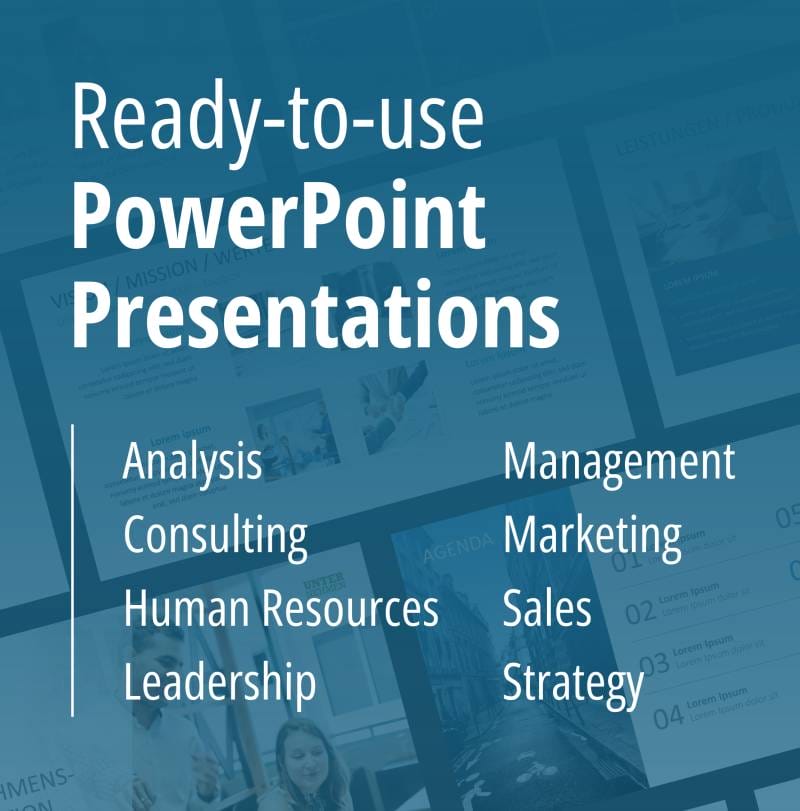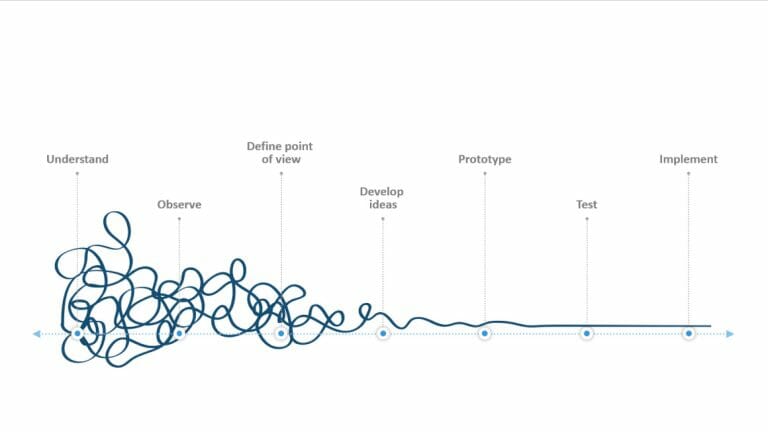
Key Message In PowerPoint Presentations: How to Develop and Convey your Core Message correctly!
Our brain is a highly efficient filter for information, which is incredibly useful. If our brain were to store all the information that bombards us every day, there would be little space left for the important things. However, our brain decides for itself what it deems important.
While this filtering mechanism is helpful, it can also pose a challenge. When we want to consciously store something, we need to convince our brain to do so. Fortunately, with the right techniques and tricks, it is possible – and you can leverage this when conveying the key messages of your presentation!
Presenting the Key Message: Heard Today, Forgotten Tomorrow?

When delivering a presentation, you typically have an intention behind it. This can range from marketing products or services to imparting knowledge or persuading your audience about a certain matter.
The main goal is to convey that your method works or your product provides a solution for a specific problem. In essence, you are imparting knowledge to your viewers on a particular topic.
While a concise and well-crafted presentation can effectively convey information, it may not have a lasting impact if the information only superficially resonates with the audience and is not linked to a memorable message. Even a great presentation can quickly be forgotten, and the audience may not retain the crucial facts.
Therefore, it is advisable to strategically place the information in your PowerPoint presentation from the outset. This ensures that your key message remains in your audience’s memory for a long time.
In the following 5 steps, we will show you how to structure your presentation around the key message to guarantee that it remains memorable for your viewers.
Create a memorable presentation in 5 steps
Step #1: Formulate the Key Message of Your Presentation
At the beginning of your preparation, you need to identify the core message. Before you think about how to deliver your content, you must determine what the essence of your topic should be. What should your presentation revolve around? What do you want to convey to your audience, and what do you aim to achieve with your presentation?
Consider the context of your presentation as well. What type of presentation are you giving and who are your audience? How should you develop the key message and where should you focus?
In business presentations, the focus is often on communicating value and benefits to customers or investors. Educational presentations, on the other hand, may emphasize knowledge and understanding. Political speeches may aim for persuasion and mobilization. It is important to consider the context and adjust the key message accordingly to achieve the desired impact. Each context requires an individual approach to effectively convey the key message.
The core message of your presentation doesn’t necessarily have to be fully developed when you start creating your slides. However, it is important to note that solidifying the key message early in the preparation process can make your work easier and potentially save you from later changes and adjustments.
In any case, a well-crafted message should form the core of your work. Your key message can serve as a filter for all your content and should be structured in a way that the arguments, content, and materials of your presentation support and build upon it.
Step #2: Ensure Clarity in Your Key Message
While the significance of your key message may be well-developed, it means little if the wording is not right. The more understandable and memorable your core message is formulated, the easier it is for your audience to understand and remember it.
The best slogans are short and concise, making them easily memorable. For example, “Quadratisch. Praktisch. Gut.” or “Morgens, halb zehn in Deutschland.” Without mentioning the brand names, you likely know which products these slogans describe.
To achieve this, it is advisable to structure your key messages in a simple and concise manner. Avoid overly complex or vague statements that may confuse or fail to convince your audience.
For the clarity of your key message, it is also important to provide sufficient justification or support it with relevant information. The key message should be built on a solid foundation of arguments and facts.
To achieve this, it is advisable to keep your key statements simple and concise.
Step #3: Making Your Key Message Stick!
Once you have developed a key message, the next step is to ensure that your message not only resonates but also remains impactful. The message should stay in the minds of your audience and continue to have an effect beyond the moment of the presentation.
How can you ensure that the message finds its way into the long-term memory of your audience? How can you effectively market your key message in PowerPoint?
In this case, less is more for the entire presentation. The more information bombards us, the more our brains filter it out. If you convey too much information in your presentation, there is a high probability that much of it will be forgotten, including the truly important points, such as your key message.
For this reason, it is essential to make your presentation as concise as possible. Make sure to eliminate irrelevant details and unimportant information. For more information on avoiding information overload on your slides, we recommend reading our article “Avoid Information Overload.” Don’t hide the needle, in this case, your key message, in a haystack, but serve it to your audience on a silver platter.
However, when it comes to your key message specifically, the opposite applies: more is more. The more we hear something, the easier it sticks in our memory. Therefore, it is important to clearly highlight the core thesis multiple times during the presentation.
Step #4: Placement of the Key Message

Unlike in advertising, where slogans can be repeated multiple times on TV or the internet, you don’t have the same opportunity to repeat your key message endlessly in a presentation. Therefore, the placement of the key message in your presentation becomes even more important. Once your core message is clearly formulated, you have already laid the foundation to strategically position and emphasize it effectively.
It is crucial that your entire presentation is structured in a way that showcases your PowerPoint key message. Often, PowerPoint structures in many presentations follow a classic funnel-shaped approach. Such a presentation starts with a broad level of gathered facts, from which a specific argumentation is derived.
This argumentation is then supported by examples, with the key message being presented at the very end of the presentation. In the business world, where efficiency and persuasiveness are crucial, the so-called funnel principle may not necessarily be the best choice.
To ensure that your key message is effectively conveyed and remembered, consider alternative presentation structures that place the key message upfront or intersperse it strategically throughout the presentation.
For example, you could begin with a provocative statement or a powerful visual that immediately captures the audience’s attention and conveys the essence of your message. This approach helps to engage your audience from the beginning and keeps them focused on the core message throughout the presentation.
Additionally, reinforce your key message by repeating it at crucial points during the presentation. This repetition helps to reinforce the message in the minds of your audience and increases the chances of them remembering it.
By strategically placing and reinforcing your key message throughout your presentation, you can ensure that it is effectively communicated and leaves a lasting impression on your audience.
Presentation structure according to the pyramid principle
Contrary to the funnel-shaped approach, the pyramid principle can serve as a template to make a presentation more engaging.
With the pyramid principle, the approach is exactly the opposite, placing the key message at the forefront as the starting point of the presentation, strategically supported by examples and facts. Once you have formulated your key message clearly and memorably, it will immediately capture the interest of your audience. The objective of the presentation is already established, making it much easier for your audience to follow your argumentation.
To learn more about PowerPoint structure, feel free to check out our article on “Presentation Structure.”
Step #5: Active Learning Instead of Passive Learning
It is widely known that learning can be categorized into active and passive. Passive learning includes reading, watching, or listening without actively engaging in the process. However, we learn much more efficiently when we are actively involved. You can take advantage of this when conveying your key message.
Invite your audience to actively think and participate. This can be done by asking questions such as, “What experiences have you had with this?” or encouraging them to speculate, “What do you think the conclusion will be?”.
If suitable for your topic, you can also incorporate small activities like a memory exercise. Such exercises activate the attention of your listeners and ensure that your presentation stays in their memory for longer. For more tips on “interactive presentations,” feel free to visit our blog.
By using the pyramid principle and incorporating active learning techniques, you can effectively develop and communicate your key message, ensuring that it resonates with your audience and leaves a lasting impact.
Bonus Tips for Better Memorability:

1. Work with Emotions
Emotions give events personal meaning to us. When events are associated with emotions, we find it easier to remember them. Harness this power in your presentation to convey your PowerPoint key message!
There are various proven techniques to enhance the key message of a presentation and make it more convincing for the audience. One approach is to use storytelling, where a captivating narrative is employed to convey the message.Find out more about how to evoke emotions in your audience in our article on “Storytelling“.
Furthermore, rhetorical devices such as repetitions, metaphors, or questions can be used to capture the audience’s attention and emphasize the key message effectively.
2. Multidimensionality over Words
The more connections the human brain can make, the easier and more lasting the memory. Therefore, make sure to convey your key message in a diverse manner. Utilize images, graphics, devices, and wordplay such as rhymes or alliterations to enhance memory retention. References to well-known movies or TV shows can also help trigger the memory of your key message long after your presentation.
A well-designed visual representation can aid in simplifying complex information and enhance understanding and retention of the key message. Additionally, the visual design of the presentation should align with the key message and maintain a cohesive and visually appealing aesthetic.
3. Practical Relevance
Effective Learning Method: Depending on how long it has been since your school days, you may remember how tedious rote memorization of rules and formulas can be. Learning through examples and deriving corresponding rules independently is a much more effective learning method.
To be able to work with learned information in the long run, our brain needs to understand what it absorbs. Keep this in mind during your presentation and provide concrete and practical connections to your audience. This doesn’t mean that presenting data and facts is inherently meaningless, but rather that your key message should always have a relevant practical context.
4. Handout as a Reminder
Prepare a handout. Distribute it after the presentation and give the audience the opportunity to review the presentation on their own. Ensure that your key message is prominently featured in the handout. Learn more about creating effective handouts in our article on “Handouts“.
One last trick that offers dual benefits: Ask the audience for feedback via email or online survey. This encourages your participants to engage with the presentation again, and you also receive valuable feedback. Discover how to cleverly incorporate a request for feedback into your presentation in our article on “Feedback”.
Develop Crystal Clear Core Messages with the SUCCESS Method
The SUCCESS method is an acronym that provides a framework for creating and assessing core messages in presentations to ensure they resonate and stick in the minds of the audience. Here’s what each letter stands for:
- S – Simple
The core message should be clear and easy to understand. The audience should be able to grasp it quickly.
- U – Unexpected
The message should be surprising or unexpected to capture attention and spark interest. Surprise is the spice of any presentation. Incorporate unexpected elements to maintain attention and spark interest.
- C – Clear
Your key statement should be concrete and quickly comprehensible. Statements should make immediate sense to avoid any abstraction and ensure the message stays grounded.
- C – Credible
The message must be believable and realistic. Credibility can be enhanced by supporting your message with facts, expert opinions, or case studies.
- E – Emotional
The core message should evoke emotions. People often make decisions based on how they feel, so tying emotions to your message can strengthen its impact.
- S – Story
Your message should offer material for good storytelling. Incorporating a storyline can help present the information in a memorable way.
You can find helpful tips about this topic in our blog “Storytelling in Presentations“.
- S – Style
The style and design make the presentation unique. Everything from the slide design to the choice of images, icons, and infographics should be as powerful as your message.
By following these guidelines, you can assess how well your core message meets each point. The more boxes you can tick, the more effective your presentation will be.
Conclusion: Stay in the memory with your key message!

As described in this article, it is indeed possible to create a presentation that leaves a lasting impression and ensures that you and your message are not forgotten. Follow our 5 steps for creating a memorable key message and see the results for yourself!
If you have any questions about PowerPoint key messages or PowerPoint in general, feel free to reach out to us at [email protected]. We’re here to assist you.
Are you looking for professionally designed slide templates to support your key message? Visit our shop for a wide range of slides on various (business) topics available for download. Explore our shop today! ►Go to Shop
You may also be interested in other articles:




